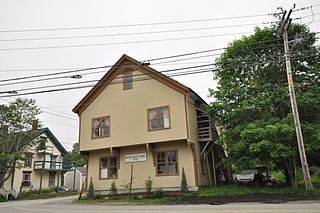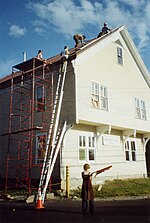
A logo is a graphic mark, emblem, or symbol used to aid and promote public identification and recognition. It may be of an abstract or figurative design or to include the text of the name that it represents as in a wordmark.
Astroturfing is the practice of hiding the sponsors of a message or organization to make it appear as though it originates from, and is supported by, grassroots participants. It is a practice intended to give the statements or organizations credibility by withholding information about the source's financial backers. The term astroturfing is derived from AstroTurf, a brand of synthetic carpeting designed to resemble natural grass, as a play on the word "grassroots". The implication behind the use of the term is that instead of a "true" or "natural" grassroots effort behind the activity in question, there is a "fake" or "artificial" appearance of support.

Finlandia is a brand of vodka produced in Finland. It is made from barley distilled into a neutral spirit in the village of Koskenkorva in Ilmajoki, operated by Finland's Altia Corporation. The distilled alcohol is then transported to a production facility in the village of Rajamäki in Nurmijärvi, about 45 kilometers north of Helsinki. In Rajamäki, the spirit is blended with glacial water, flavored, and bottled.
CrimethInc., also known as CWC, which stands for either "CrimethInc. Ex-Workers Collective" or "CrimethInc Ex-Workers Ex-Collective", is a decentralized anarchist collective of autonomous cells. CrimethInc. emerged in the mid-1990s, initially as the hardcore zine Inside Front, and began operating as a collective in 1996. It has since published widely read articles and zines for the anarchist movement and distributed posters and books of its own publication.

Frank Shepard Fairey is an American contemporary artist, activist and founder of OBEY Clothing who emerged from the skateboarding scene. In 1989 he designed the "Andre the Giant Has a Posse" (...OBEY...) sticker campaign while attending the Rhode Island School of Design (RISD).
Josh MacPhee is an artist, curator, stonemason and activist living in Brooklyn, New York.
Domesticated plants of Mesoamerica, established by agricultural developments and practices over several thousand years of pre-Columbian history, include maize and capsicum. A list of Mesoamerican cultivars and staples:

Defective by Design (DBD) is a grassroots anti-digital rights management (DRM) initiative by the Free Software Foundation (FSF) and CivicActions. Launched in 2006, DBD believes that DRM makes technology deliberately defective, negatively affects digital freedoms, and is "a threat to innovation in media, the privacy of readers, and freedom for computer users." The initiative regularly campaigns against the use of DRM by the media industry and software industry to increase awareness of the anti-DRM movement and pressure industries into no longer using DRM. They are known for their use of hazmat suits in their demonstrations.
THINK AGAIN is an artist-activist collaborative founded in 1997 by David John Attyah and S. A. Bachman. THINK AGAIN expects something political from art and uses images to challenge indifference. The collaborative views cultural work as essential to affecting social change and engaging people in the political process. Their work — mobile billboards, outdoor projections, guerilla interventions, digital murals, and viral poster campaigns — links the global to the local and combines cultural theory, sociological research, and activism to create a visual language for activating civic dialogue. The projects of THINK AGAIN explore a unique range of issues including queer liberation, economic inequality, the ways capitalist culture conspires to jeopardize the outnumbered, undocumented labor and the treatment of immigrants, racism, militarization, gentrification and displacement, and gender parity.
Grapus was a collective of graphic artists working together between 1970 and 1991 that sought to combine excellence in design with a social conscience.
The Taller de Gráfica Popular is an artist's print collective founded in Mexico in 1937 by artists Leopoldo Méndez, Pablo O'Higgins, and Luis Arenal. The collective was primarily concerned with using art to advance revolutionary social causes. The print shop became a base of political activity and abundant artistic output, and attracted many foreign artists as collaborators.

Favianna Rodriguez is an American artist and activist. She has self-identified as queer and Latina with Afro-Peruvian roots. Rodriguez began as a political poster designer in the 1990s in the struggle for racial justice in Oakland, California. R is known for using her art as a tool for activism. Her designs and projects range on a variety of different issues including globalization, immigration, feminism, patriarchy, interdependence, and genetically modified foods. Rodriguez is a co-founder of Presente.org and is the Executive Director of Culture Strike, "a national arts organization that engages artists, writers and performers in migrant rights. "
Graphic design is the practice of combining text with images and concepts, most often for advertisements, publications, or websites. The history of graphic design is frequently traced from the onset of moveable-type printing in the 15th century, yet earlier developments and technologies related to writing and printing can be considered as parts of the longer history of communication.

The Former Machias Valley Grange, No. 360 is a social and civic meeting hall at 1 Elm Street in Machias, Maine. Built in 1907, it features a distinctive design that eliminates support posts in its dining hall and auditorium. Now owned by a local artists' cooperative, it continues to function as a social and civic meeting space. It was listed on the National Register of Historic Places in 2007.
Undertow Brass Band is a brass band with approximately 18 active members from Providence, Rhode Island, United States. They perform using exclusively brass instruments, saxophones, and drums in a variety of world styles, such as Indian Bollywood music, Balkan brass, klezmer, as well as American styles such as hip hop, rock, and New Orleans second line music.
The Palestine Poster Project Archives (PPPA) was founded as a means of collecting and digitally displaying a wide variety of works in the Palestine poster genre. The Palestine poster genre is more than a century old and growing. The Palestine Poster Project Archives continues to expand as the largest online collection of such posters.
The Canadian Centre for Bio-Ethical Reform is an anti-abortion group based in Calgary, Alberta, Canada.
Dyke Action Machine! or DAM! is a public art and activist duo made up of painter and graphic designer Carrie Moyer and photographer Sue Schaffner. DAM! gained notoriety in the 1990s for using commercial photography styling with lesbian imagery in public art.
Pat Perry is an American painter and street artist based in Detroit, Michigan. He is best known for a series of sketchbooks and 35mm photographs documenting years of itinerant traveling around the United States and painting realistic depictions of 21st century America. His practice also includes mural painting, photography, illustration, storytelling, and freight train tagging.








